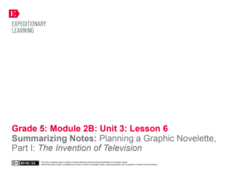Curated OER
Getting to Know You
After going over the five steps of the writing process, pupils fill out "Getting to Know You" worksheets. They trade papers with each other, and have the task of writing a descriptive paragraph about the person whose worksheet they...
Curated OER
Vivid Verbs
Spice up your writing! Your amateur writers will benefit from concentrating on understanding and improving verb use in writing. An introductory activity addresses weak verbs. A second exercise helps them see the importance of strong...
Project Noah
Writing Goes Wild
Young scientists develop their observation and writing skills as they craft and then post a detailed description of a plant or animal they have spotted and photographed.
Curated OER
Write A Description
Learners practice composing sentences that pertain to the description of a picture. They use critical observation skills in order to derive the best details. The sentences are required to follow the correct subject and verb pattern.
Curated OER
Indescribably Excellent Descriptions
Students train their eyes to look more closely at detail and imperfections as they write "indescribably" excellent descriptions of places, people, and things!
Curated OER
Adjectives and Descriptive Phrases
Learners examine the use of adjectives and descriptive phrases to improve their written pieces. In this adjectives and descriptive phrases lesson, students look at demonstrative adjectives, common adjectives, and proper adjectives. They...
Curated OER
Finding the Subject
Students explore sentences to locate subjects. In this language lesson, students investigate methods to locate subjects in sentences and practice doing so.
Curated OER
Writing a Descriptive Paragraph
Students discuss the definition of a descriptive paragraph with the class. They read an example of a descriptive paragraph and then write one of their own using one of the included ideas.
Curated OER
Descriptive Writing
Students create a descriptive paragraph about themselves and use a PowerPoint template to add a picture. Students participate in a brainstorming session of descriptive words to use for their paragraph before beginning their assignment.
Curated OER
Writing Descriptions of "My Favorite Place"
Students write a descriptive writing piece. In this writing activity, students use a visualization exercise to add more descriptions to their writing.
Curated OER
Descriptive Writing
Second graders analyze descriptive writing. In this writing lesson, 2nd graders read a story with a villain, describe the villain in words, and create a Wanted Poster describing him on paper.
EngageNY
Summarizing Notes: Planning a Graphic Novelette Part 1: The Invention of Television
What's the story? Learners create the first of four storyboards about the invention of the television, incorporating narrative techniques and descriptive details. Next, they offer and receive feedback by participating in a peer critique...
Curated OER
Character Analysis Chart
This versatile graphic organizer could be used alongside any novel, poem, play, or story through which your class in studying character. Class members can get characters straight or describe particular characters in more detail with this...
Fluence Learning
Writing About Literature: Comparing and Contrasting Characters in Heidi
Scholars read excerpts from the story, Heidi, in a three-part assessment that focuses on comparing and contrasting characters. Each part contains three tasks that challenge learners to discuss, answer comprehension...
Curated OER
Read All About it
Learners create and publish a newspaper that reflects and explains pioneer and medieval societies. They become newspaper writers for a specific time period. They adopt a holistic approach to exploring community life in medieval and...
Curated OER
Descriptive Paragraphs
Third graders gain the necessary skills to write a descriptive paragraph. They see the evaluation and decision making process that are used in good wriitng. The bible is used to see illustrations and then used to paint a picture in...
Conneticut Department of Education
Instructional Strategies That Facilitate Learning Across Content Areas
Imagine 28 instructional strategies, appropriate for all subject areas and all grade levels. Directed Reading-Thinking Activities (DRTA), Question-Answer Relationship (QAR) activities, KWL charts, comparison matrixes, classification...
New York City Department of Education
Egypt
This six-week unit encompasses all subjects with a focus study on world history and the development of ancient civilizations. As gifted and talented students dive into the interesting yet challenging topic of Egypt, they...
Florida Center for Reading Research
Vocabulary: Word Analysis, Meaning Map
Lead young learners to understand new vocabulary with this series of word maps. The first of these organizers asks children to determine the definition and provide examples and descriptions of each word with the help of dictionaries,...
Houghton Mifflin Harcourt
Special Friends: English Language Development Lessons (Theme 9)
Enhance language proficiency with a Special Friends themed English language development unit. Each lesson follows a listen, speak, move, and/or look routine that is guaranteed to get your scholars discussing topics such as animal...
Curated OER
Communicating Feelings through
Sixth graders use subjects, themes, and symbols to communicate meaning in their own works of art. They describe the origins of specific images and ideas and explain why they are of value in their artwork and in the work of others.
Curated OER
Poetry Gifts
What kind of shoe is this person? What time of day is this person? Aspiring poets’ responses to a list of questions provide descriptive words and phrases that can be crafted into a blank verse poem. A link to sample poems is provided.
Poetry Society
Simile and Metaphor
Young poets use word cards to prompt a metaphor poem comparing to very dissimilar items.
BrainPOP
Famous Historical Figures Lesson Plan: Who Am I?
History detectives select a famous person to research, fill a bag with items associated with their subject, then ask class members to guess the historical figure represented by the artifacts.

























